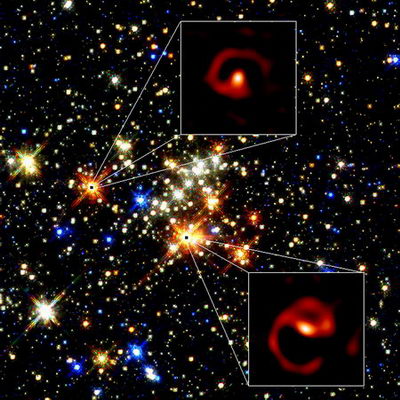The nature of the stars was not entirely clear until now. In a paper published in the Aug. 18 issue of Science, co-authors Peter Tuthill of the University of Sydney and Donald Figer of Rochester Institute of Technology show that the Quintuplet cluster consists of young massive binary stars that produce large amounts of dust. Their data reveal that five bright red stars are nearing the end of their "short" lives of approximately 5 million years. These quickly evolving stars burn fast and bright, but die younger than fainter stars, which live for billions of years. The study captures the Quintuplet stars just before disintegrating in supernovae explosions.
Using advanced imaging techniques on the world's biggest telescope at the W.M. Keck Observatory in Hawaii, the scientists captured the stars at the highest attainable resolution for the instrument, far exceeding the capability of the Hubble Space Telescope, which imaged the cluster a decade ago. The extra-resolution gives scientists a new glimpse of the dust plumes surrounding the stars and the swirling spirals Tuthill likened to pinwheels when he identified the first one in 1999 elsewhere in the galaxy.
"Only a few pinwheels are known in the galaxy," Figer says. "The point is, we've found five all next to each other in the same cluster. No one has seen anything like this before."
Sponsored Links (Ads by Google)
Image Quality Filters
Visible and NIR narrowband optical filters for high resolution.
Astronomy for Australians
Astronomy Online guides & products Telescopes Forums Binoculars & Acc
The Final Theory
The bestselling book our scientists hope you never read. Find out why.
"The only way that pinwheels can form is if they have two stars, swirling around each other. The stars are so close that their winds collide, forming dust in a spiral shape, just like water sprayed from a garden hose of a twirling sprinkler," Figer says. "A single star wouldn't be able to produce the dust and wouldn't have the spiral outflow."
An earlier study by Figer in 1996 claimed the Quintuplet cluster consists of evolved massive stars that produce dust. Figer's research could not be confirmed until now with the use of the Keck telescope.
"If you want to understand star formation, you have to understand if they are forming alone or if they have partners," Figer says. "The answer gives us a clue as to whether stars form alone or with companions."
Source: Rochester Institute of Technology


